Habs Drafting Since 2012 – Good, Average or Barren?
January 10, 2018
By Grant McCagg
A few weeks ago I got into a debate with TSN’s Ray Ferraro, who stated on Twitter that the Habs have consistently missed on their high picks in recent years and had drafted very poorly.
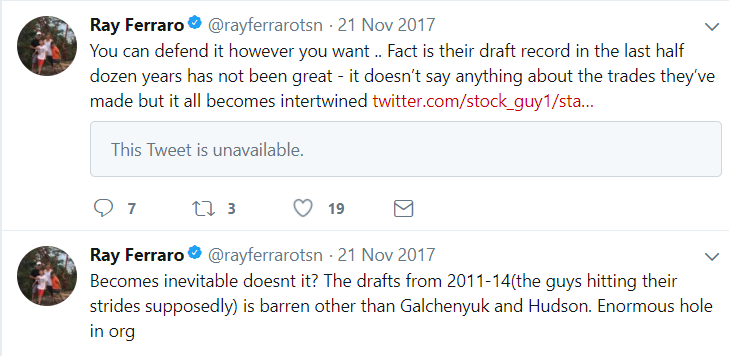
He deleted another tweet that said the Habs had “miss after miss” with their first picks, and after someone forwarded him a link to a draft article I had written that disputes that the Habs have drafted poorly, Ferraro later contacted me by direct message and it ended up getting into a pretty animated exchange where at one point it looked like we’d be ending the matter with hard feelings and the mute button.
Alas, we managed to smooth things over, in large part because I respect Ferraro and think he’s one of the better analysts in hockey, and after he discovered that I had actually scouted in the NHL and wasn’t just an opinionated media guy with no NHL background, we managed to end the conversation on good terms, and have DM’ed each other since cordially. We even exchanged Christmas greetings.
Last week during the World Juniors Ferraro noted to Gord Miller that a team must consider a draft to have been successful if a club can end up with two regular NHLers. I found that interesting after his harsh criticism of the Habs drafting “in recent years”, as it looks like the Habs have, and will in the future, manage to do just that.
When one looks at the Habs draft record in the past six years, it’s hard not to determine that there will be a minimum of 12 players who will find regular employment in the NHL, and several should also make a decent impact.
As is the case with any argument, there are two sides to the debate. If one can criticize a team for not already having produced impact NHLers in recent drafts despite having just one top-25 pick in the past five years, one can also argue that players who have yet to make the NHL may, in fact, one day be regular NHLers.
Draft position is extremely important in judging how a team drafts, as research data has shown that less than 50 percent of players selected between 20-30 become regular NHLers. You need to go back more than five years for a fair judgement, so look at the drafts from 2009-11 as examples. Seventeen of the 30 players chosen between 21 and 30 have yet to find regular employment in the NHL.
Using those statistics…one would surmise that, if they are lucky, two of the four players Montreal has taken with the 25th and 26th picks in the past five drafts will play in the NHL.
Ray is quite correct in saying that an NHL team is lucky to have two players from each draft that make the league, especially a team that doesn’t pick in the top 25 very often, and in Montreal’s case, no second-round selections between 2014-16 either. Expecting the Habs to have already had impacts NHLers from the past five years considering all of these roadblocks is not considering all of the factors fairly in my opinion.
Here is a review of Montreal’s drafts and prospects from the past six years:
In 2012 the Habs had a top-three selection for the first time since 1980 when Doug Wickenheiser was taken first overall by the club, and in a poor draft year decided to gamble on Alex Galchenyuk, a prospect who missed all but the last six games of the season with a knee injury.
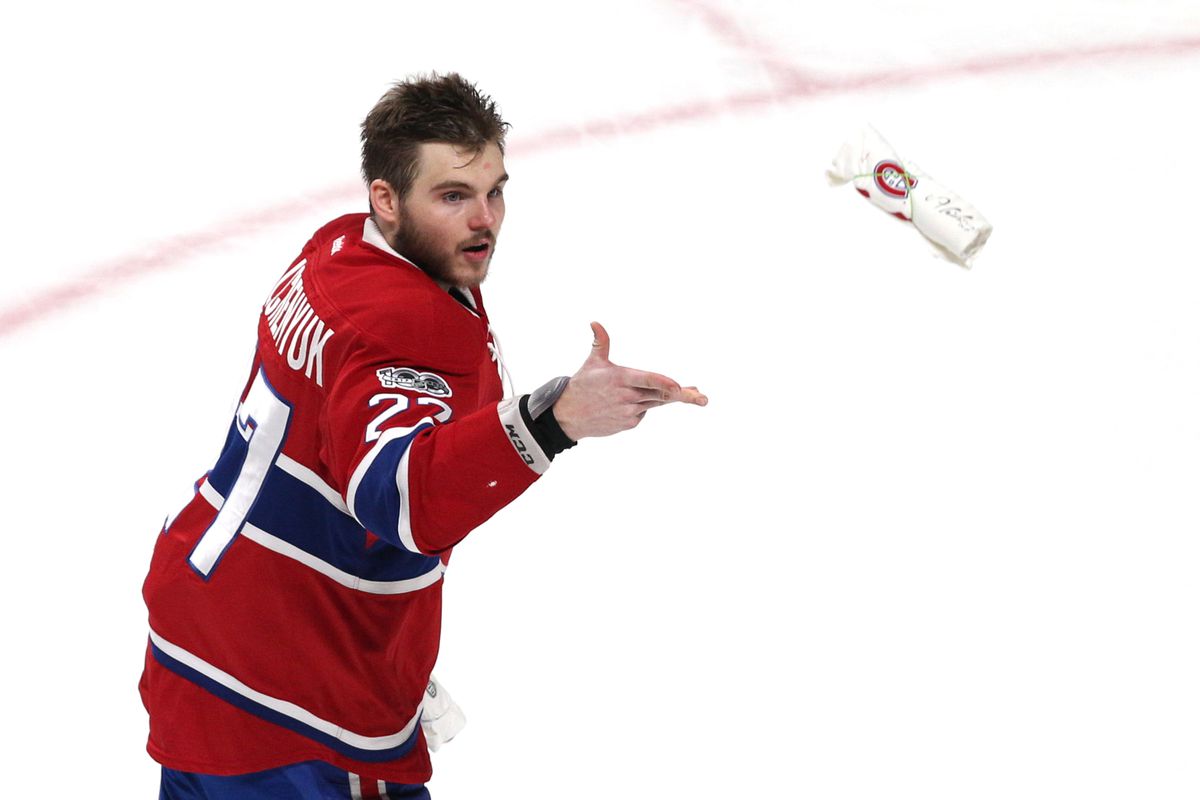
Fast forward six years and Galchenyuk is the top point producer from his draft class, so it’s hard to argue that they made the wrong choice. Has he turned into a superstar who solved their issues at first-line center? No…not yet at least, and as time has shown…there were no first-line centers in that draft class – the Habs didn’t miss on one. When one looks back to that year..there were plenty of Habs fans who insisted that Mikhail Grigorenko was the right guy to pick and that he’d be the future number-one center in Montreal…it’s a good thing the fans don’t make the picks.
The Habs had two second-round picks in that draft and missed on both of them when they took Sebastien Collberg and Dalton Thrower. There are no two ways around it..both turned out to be disappointing picks, but if one takes the time to go back and see who else was selected in the second round in 2012…it’s not like they missed out on gems either. As of today, there aren’t three or four NHL regulars, and the NHL career points leader is Chris Tierney with 80 points.
Montreal’s early third-round pick that year was Tim Bozon, and he came perilously close to dying in his last season of junior with Neisseria meningitidis. He is lucky to be alive let alone even playing hockey, so it’s tough to blame the Habs for making a poor selection in his case…one can never predict that a draft pick will later contact meningitis.
In the fifth round, the Habs selected Charles Hudon, one of just eight players selected in the final three rounds of 2012 to be playing in the NHL today, and he has shown this season that he will be able to carve out a nice NHL career as a smart two-way winger with some offensive abilities.
So in summary, the Habs picked two players in a thin draft class who became NHLers, one of which has produced the most points of any player in the draft. Say what you will; in Ferraro’s own words…that would be a successful draft year from the “barren” Montreal Canadiens.
The Habs look to have drafted at least three NHL regulars in 2013 in Jacob de la Rose, Artturi Lehkonen and Sven Andrighetto. I also think Michael McCarron will be a regular NHLer by next season, and the main reason he’s not at this point is that he doesn’t have to be.
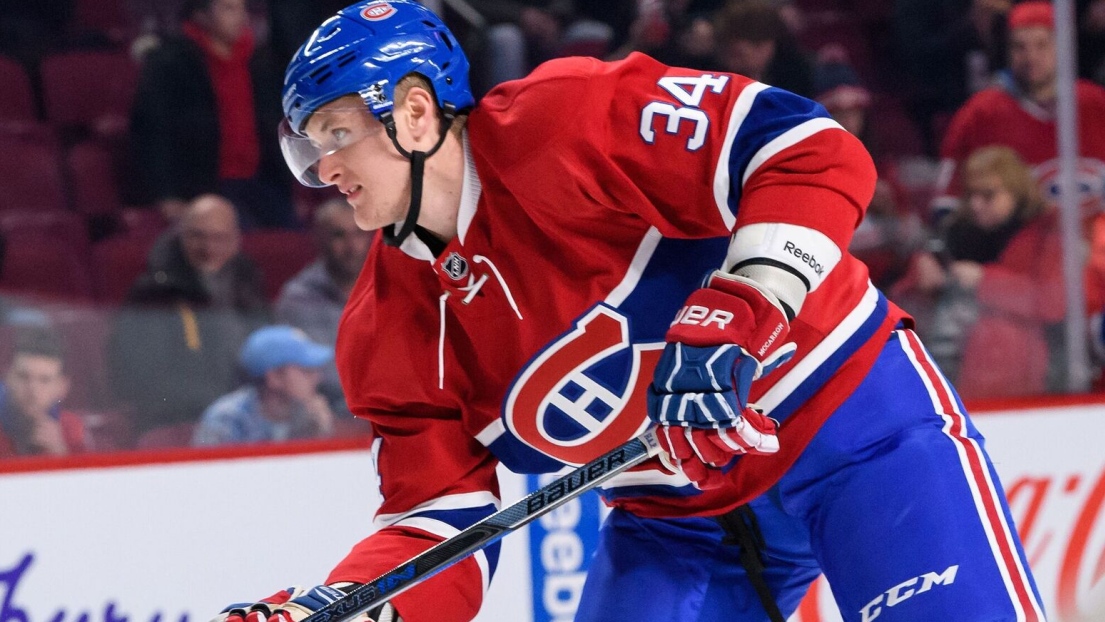
As a waiver exempt prospect, the Habs are developing him in the AHL without worries of losing him on waivers. Most 6-6 prospects take time to develop – Brian Boyle being a prime example and the player I most favourably compare to McCarron – and it would be sage not to be impatient or harsh to judge 100 percent whether McCarron will be an NHL regular down the road. It’s not like he’s an average AHLer; he’s one of the better all-around forwards in the league, and he’s just 22. Timmins told me when he drafted him that he would need at least five years, and that has held true.
Even if he doesn’t become an NHL regular, then it means he’ll be one of those many picks made between 21 and 30 that doesn’t make it, just like Shinkaruk, Klimchuk, Dickinson, Poirier, Gauthier from the same draft, so to be highly critical of Timmins for possibly selecting one player after the top 24 in the past five drafts who may not be an NHL regular is ignoring draft stats. The odds of picking four straight players 25-30 in the draft who all pan out is quite low.
Calgary is a team that has had a lot of picks between 21-30 in the past 14 drafts so let’s have a look at their success rate as a gauge.
In a ten-year span between 2004-13, the Flames selected Kris Chucko, Matt Pelech, Leland Irving, Greg Nemisz, Tim Erixon, Mark Jankowski and Emile Poirier with picks between 21-30. Combined they have played 181 NHL games. McCarron, selected less than five years ago, has already played 59 games.
The only pick in the 20’s Calgary made in that period who has succeeded was Mikael Backlund. That is one of out eight, and if you assume Jankowski will be a regular it is two out of eight….or 25 percent.
Five players drafted after McCarron in the top 60 of the 2013 draft have played more games, and two of them, de la Rose and Lehkonen, were Habs picks.
Montreal’s selections from 2013 have played 384 games to date, and that is fifth overall in total games among all NHL teams behind Colorado, which picked first overall, Carolina which had the fifth overall pick, Buffalo with two picks in the top 16 and Columbus which left the draft with three picks in the top 27. Not bad for a team that didn’t select before pick 25.
You can critique the Habs for Nikita Scherbak not being an NHL regular at this point, but when one considers that at least 27 of the top 50 picks from the 2014 draft (with Scherbak being selected smack dab in the middle) have yet to become NHL regulars, including eight players selected ahead of him, it would be hasty to already be writing off that selection.
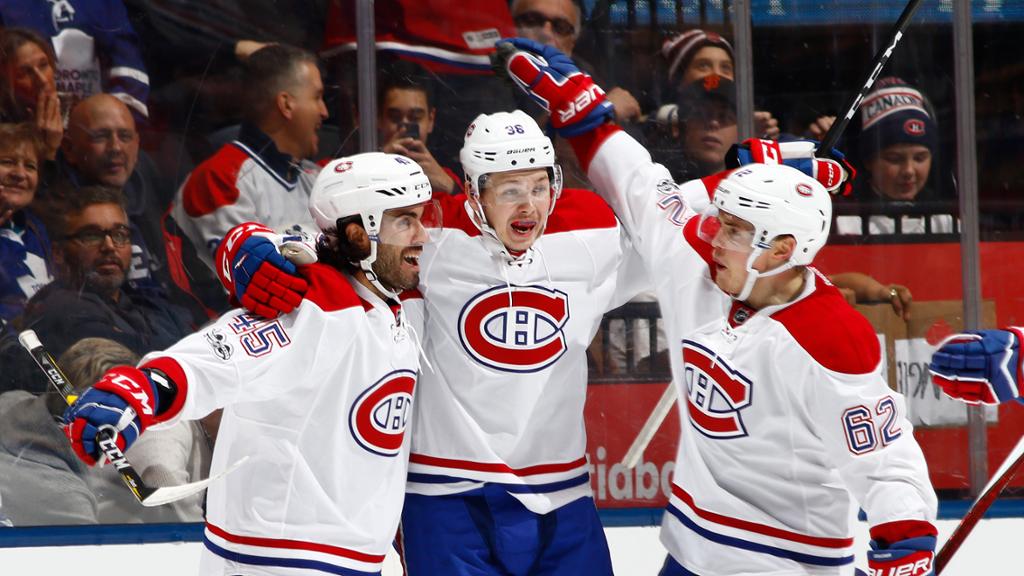
Scherbak is a slender 6-2 European still gaining strength and adjusting to the pro game. He’s taking huge steps offensively this season, and the Habs are not rushing him so he can develop at a steady pace as he continues to learn the defensive side of the game.
It’s funny..for years Detroit and New Jersey were lauded for not being impatient with prospects and letting them fully develop in the minors…when Montreal does it they are simply accused of drafting poorly when those players aren’t instantly promoted to the NHL after turning pro.
Scherbak was leading the AHL in assists per game when he was called up earlier in the season, then in his third game in Montreal suffered a knee injury that set him back. Since returning to the AHL he has continued to produce, and he remains one of the most prolific scorers in points per game despite only turning 22 last week.
He looks like he’ll be an NHL regular next season if not later this year, and quite possibly a top-six forward in the future. Three players drafted after Scherbak have played 100 NHL games, a strong indication that it’s far too early to be writing off prospects who are not yet even 23 years of age. The rule of thumb is to wait five years before starting to judge a draft pick’s potential NHL impact…so there’s still 18 months to go before you start to refer to Scherbak as a bust. I don’t see media members writing off Michael Dal Colle, Josh Ho-Sang, John Quenneville and others…folks are well aware that some prospects take longer than others, so the same patience needs to be utilized in Scherbak’s case.
Despite having just one top-60 selection in the 2014 draft, there are two other prospects who stand a decent chance of becoming NHLers in Brett Lernout and Jake Evans. Lernout has already had a callup this season, and brings many of the qualities teams look for in a bottom-pairing defenceman. He’s a gritty 6-4 defender who skates well and clears the crease with vigour.
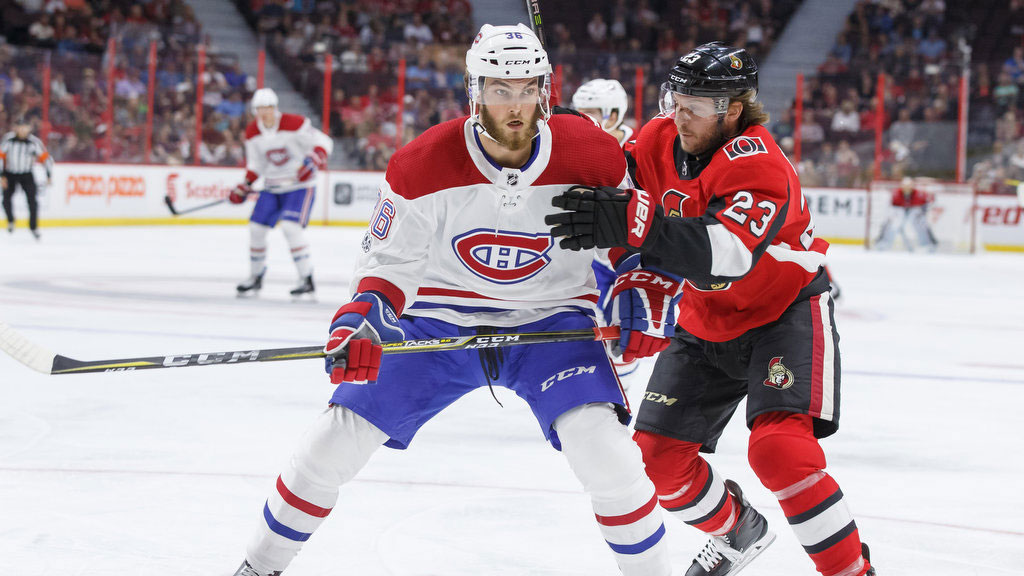
One player (Brayden Point) chosen in the third round on 2014 is playing regularly in the NHL today, and if one objectively compares Lernout to the other players taken in that third round, he looks like one of the five best prospects. Like Scherbak, the Habs are remaining patient with Lernout until he is no longer waiver eligible next season. I’d be quite surprised if he’s not on the Habs roster next season as he brings an element to his game sorely lacking on the Canadiens.
Evans has been the top scorer in NCAA hockey for most of the season, and after the Habs sign him at season’s end, if the Rocket are still playing he will join them and start his pro career. Evans is the captain at Notre Dame, and in addition to being one of the best college scorers is excellent on faceoffs, the pk and defensively.
As things have turned out Evans was a steal being taken in the seventh round, so to adjudge Montreal’s drafting in 2014 as poor isn’t looking at: A/ where they picked; B/ How many picks they had; C/ How their picks have fared in comparison to other selected in their range; with any regard to the facts.
Expect at least two of those prospects to play in the NHL from a draft where the Habs had just two selection in the first four rounds and no second rounder. If it only ends up being one player in Scherbak who makes it…given their lack of selections, that could hardly be judged as disastrous.
The 2015 draft was another draft where it must be taken into consideration that the Habs had no second-round pick either, two selections in the top four rounds, and just five picks in the entire draft. It’s not easy coming up with two future NHLers with such restrictions put on the scouting staff, yet there were three players chosen that year who are decent bets to vie for NHL jobs in Noah Juulsen, Lukas Vejdemo and Jeremiah Addison.
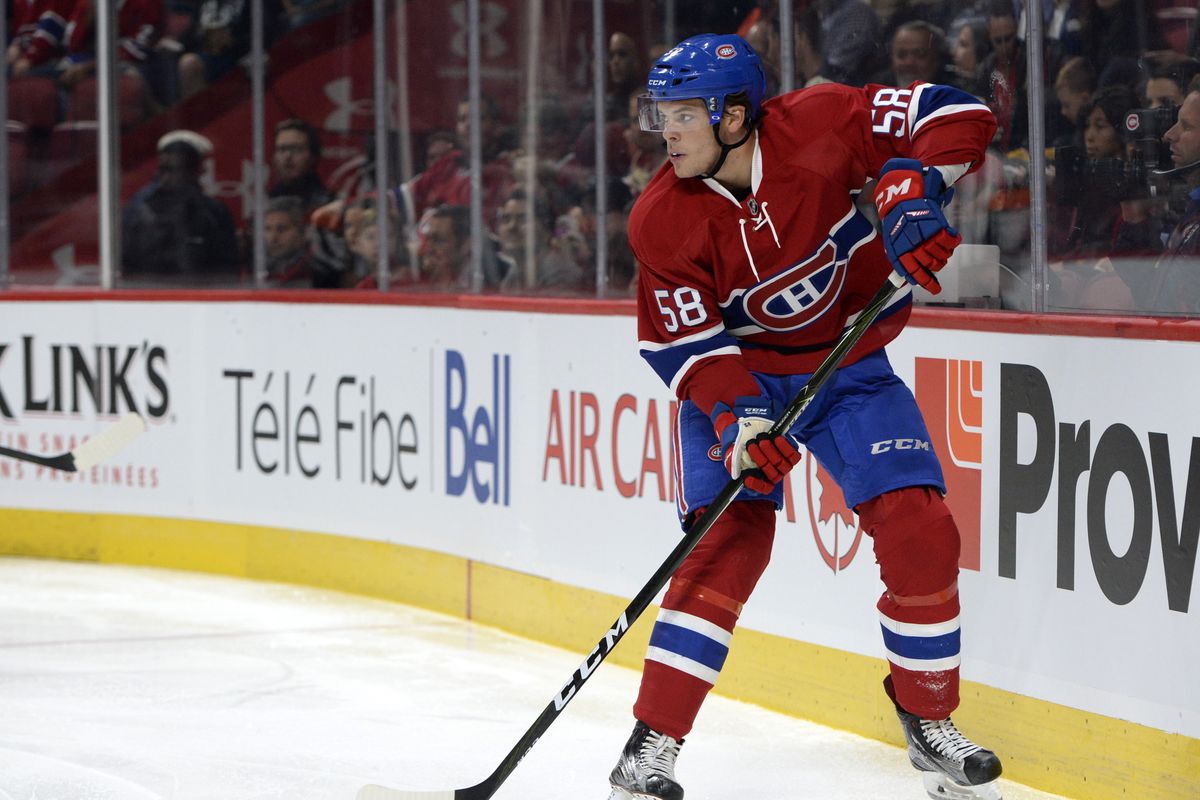
Juulsen was the cream of the crop as the only top-80 selection, and just like Scherbak he was curtailed by a serious injury that kept him out of action for the first ten weeks of the season. One of Canada’s stalwarts on the blueline in last year’s WJC, the Habs are fully expecting Juulsen to make the NHL at some point over the next 16 months; it’s only a matter of gaining some strength. Juulsen has the size. mobility, puck skills, smarts and aggressiveness to step into a top-four role in the NHL once he matures physically and gets a little more pro experience.
Vejdemo, Montreal’s third-round pick in 2015, has found his offensive game this season, and has flirted with the top 50 in SHL scoring most of the campaign. While that may not sound overly impressive, considering that the SHL is full of coaches that favour veterans and rarely play the younger prospects unless they’re elite players, it is quite notable. Two players in the SHL under the age of 22 have more points than Vejdemo, who is just 21, and they were both high picks – Rasmus Asplund and Elias Pettersson.
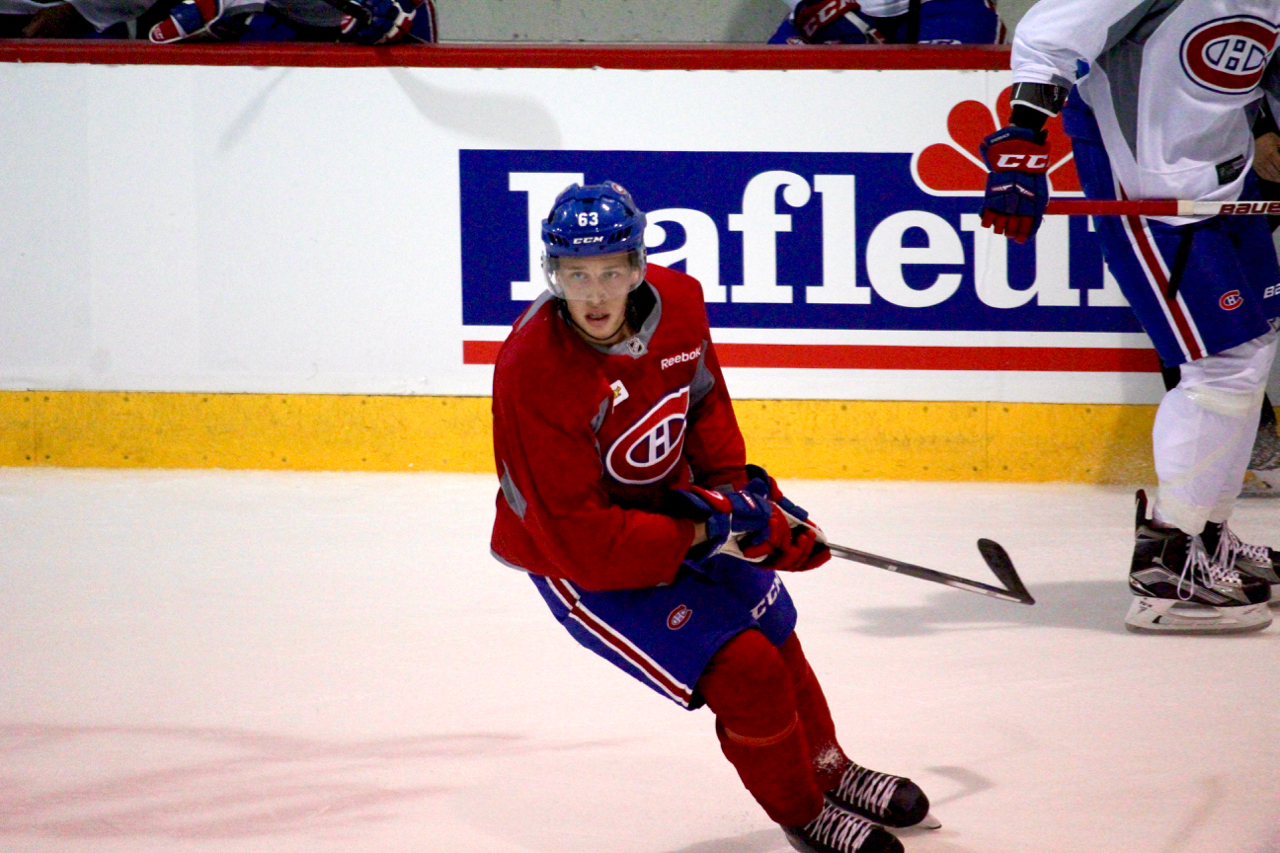
Vejdemo is sound defensively and has an impressive size/skating combination that makes him a very good candidate to make the transition to the North American game, and to play in the NHL within a couple of seasons.
Jeremiah Addison is yet another Habs prospect who fell victim to the injury bug this season, and he has yet to play a game in his first pro season. A seventh-round pick in 2015, Addison was a key part of Windsor’s Memorial Cup championship as a co-captain. Addison had five goals in four games in the Memorial Cup as well as five goals in Windsor’s five-game loss in the first round of the OHL playoffs.
In 19 career OHL playoff games, Addison scored 17 goals while playing an energetic, never-say-die two-way game. A clutch scorer and consistent competitor along with his elite character and leadership qualities, Addison embodies what NHL clubs love to have on their bottom forward lines, and he is a strong contender to one day compete for an NHL spot despite being picked in the last round of the draft.
In a draft with one top-60 pick and just five selections in total, Montreal has three solid NHL prospects. Juulsen looks like a 4-5 defenceman at worst, Vejdemo a #3 or #4 center and Addison a third or fourth-line winger. That’s a pretty solid haul, and once again…even if Vejdemo and Addison don’t end up making the NHL..one can justly argue that the Habs chose well at the draft given where and how often they picked.
Once again Timmins was without a second-round pick in 2016, making it three straight drafts that Montreal picked just once in the top 60 picks, so all things considered it may have been his best drafting job since 2007 when he chose Ryan McDonagh, Max Pacioretty and PK Subban.
If you were to redo the 2016 NHL draft today, there’s a very good chance that four Montreal Canadiens’ prospects would go in the top 100. Considering that the Habs had just one pick in the top two rounds and two selections in the top 90, it’s impressive that there are already two playing in the NHL…on the blueline no less, as 19-year-olds.
Recrutes has projected where Montreal’s best picks from 2016 would be selected if the draft were held today:
Mikhail Sergachev – 5th overall (picked 9th) – Strongly considered for the fourth overall spot as he has produced more points than Charlie McAvoy this season after being dealt to Tampa Bay for Jonathan Drouin, but McAvoy is one of the league-leaders in TOI and a much better all-around defenceman. Sergachev in a dead heat with Matt Tkachuk and Clayton Keller for their overall behind Laine and Matthews. At this point he edges out Keller for the fifth spot due to his significant size advantage; he will presumably be better defensively than Keller in the future, and put up similar point totals as a defenseman when adjusted for his position. Despite the concerns remaining with his casual play, reads and positioning defensively, safe to say the Lightning feel good about how the one-for-one trade has worked out so far as it’s rare for a 19-year-old defenceman to produce like Sergachev has even if Tampa Bay has a potent offence.
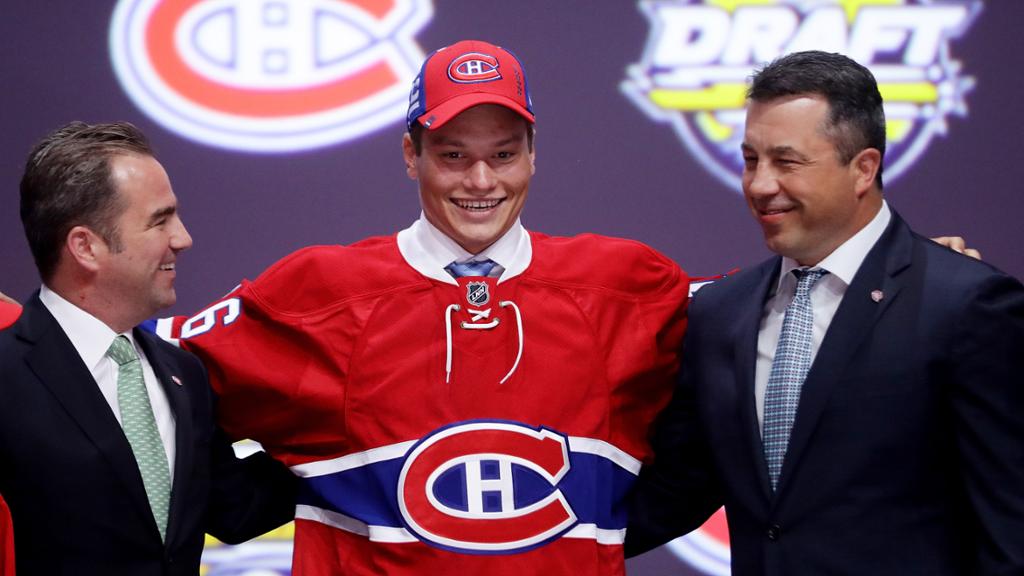
There is no questioning his offensive tools. Pierre-Luc Dubois and Jesse Puljujarvi have really been coming on, and there’s a possibility that five years from now folks would argue they are better than Sergachev…certainly it’s far too early to make any type of judgments on who will end up being better, but if you are holding the draft today, I think Sergachev likely goes ahead of those top-four picks.
Victor Mete – 32nd overall (picked 100th) – Not an easy ranking to make as he’s 13th overall in games played so far in the NHL, but we are presuming that it is simply taking some other prospects longer to develop (as it usually the case since most don’t crack the NHL for 3-4 years or more) and that in four years or so some will be better NHLers.
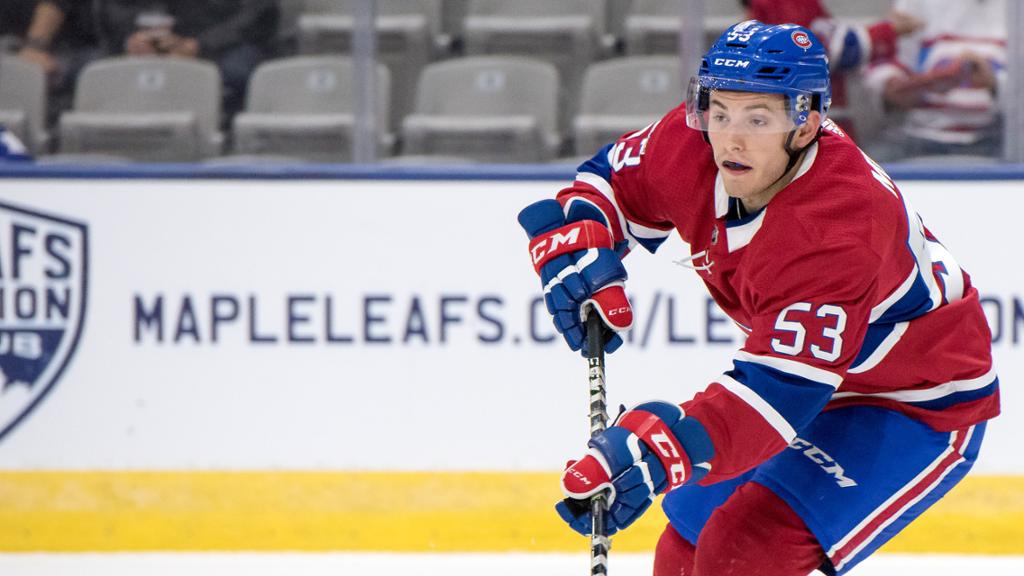
He’s already passed 68 players selected ahead of him, so don’t be surprised if he passes another ten or so in the next couple of years and a few more after that and ends up being a top 20 prospect from the 2016 draft as he keeps defying the odds. Mete was one of the top defencemen at the WJC’s, helping to lead Canada to a Gold Medal, and that was after becoming the first defenceman in draft history to be drafted after the top 70 and crack an NHL team as a regular defenceman by the age of 19.
Will Bitten – 60th overall (picked 70th) – To the surprise of the Habs organization Bitten started the OHL season slowly as he had a strong training camp. Bitten had 15 points in his first 21 games, but since then, with the exception of Morgan Frost, no one has been any hotter in the OHL. Bitten has 30 points in his last 19 games, and found another offensive level that the Habs always figured was there.
A tremendous skater and competitor, Bitten may get more breakaways than any other player in the OHL, but up until the past couple of months had trouble converting them. That said, he will never be a prolific goal scorer…he uses his outside speed, vision and passing skills to set up his linemates regularly, and there are now strong indications that he can one day compete for a third-line spot at the NHL level and offer a team consistent two-way abilities. He plays larger than his size, and is tenacious defensively. There are a lot of similarities to Paul Byron, but in a sturdier package and with better playmaking abilities. Bitten may well end up being one of the top 50 prospects from the draft if the improvement curve we’ve seen this season continues.
Michael Pezzetta – 90th overall (picked 160th) – The former 11th overall pick in the OHL Draft has finally started living up to his offensive potential this season as he’s taken a giant leap in his point totals. After two-straight ten goal-seasons Sudbury’s captain is on pace to net 30 goals and 60 points in his final junior season. Combined with all the other things he brings to a team, including size, strength, loads of grit, character, leadership, faceoff abilities, speed, defensive presence and heart, the all-around athlete is a strong bet to vie for a bottom-line position.
Yesterday Sudbury dealt Pezzetta and a 2018 eighth-round pick to the Sarnia Sting in return for two second-round draft picks, a conditional fourth-round pick and the rights to defenceman Ethan Lavallee.
How many sixth-round NHL picks do you see getting dealt for a good prospect, two second-rounders and a fourth when they only have a couple of months left in their junior career? It’s a testament to how much value Pezzetta has earned in the OHL. It will be interesting to see how he performs in the OHL playoffs for the first time in his career as he’s the type of player who should excel when the going gets tough.
To summarize – the Habs selected four players in 2016 who, if the draft were held today, would most likely go in the top 90. For a team that had only two top-90 picks, that is solid drafting by any measure.
We know at least two players from that draft will play in the NHL as they are already doing so..and in three or four years there may well be four.
Now we come to the 2017 draft, which I considered to be perhaps the Habs’ best in decades in terms of overall depth and value.
Montreal was the only team to pick four players in Recrutes top 50, six in the top 80 and seven in Recrutes top 90. Every pick was ranked higher on Recrutes’ list than where they were drafted, and nothing has taken place this season to change that. If anything, several prospects have only helped their stock.
It must have seemed like Christmas for Timmins as he went from having no second-round picks for three years to having two, and he made the most of them by selecting players who were in Recrutes top 35.
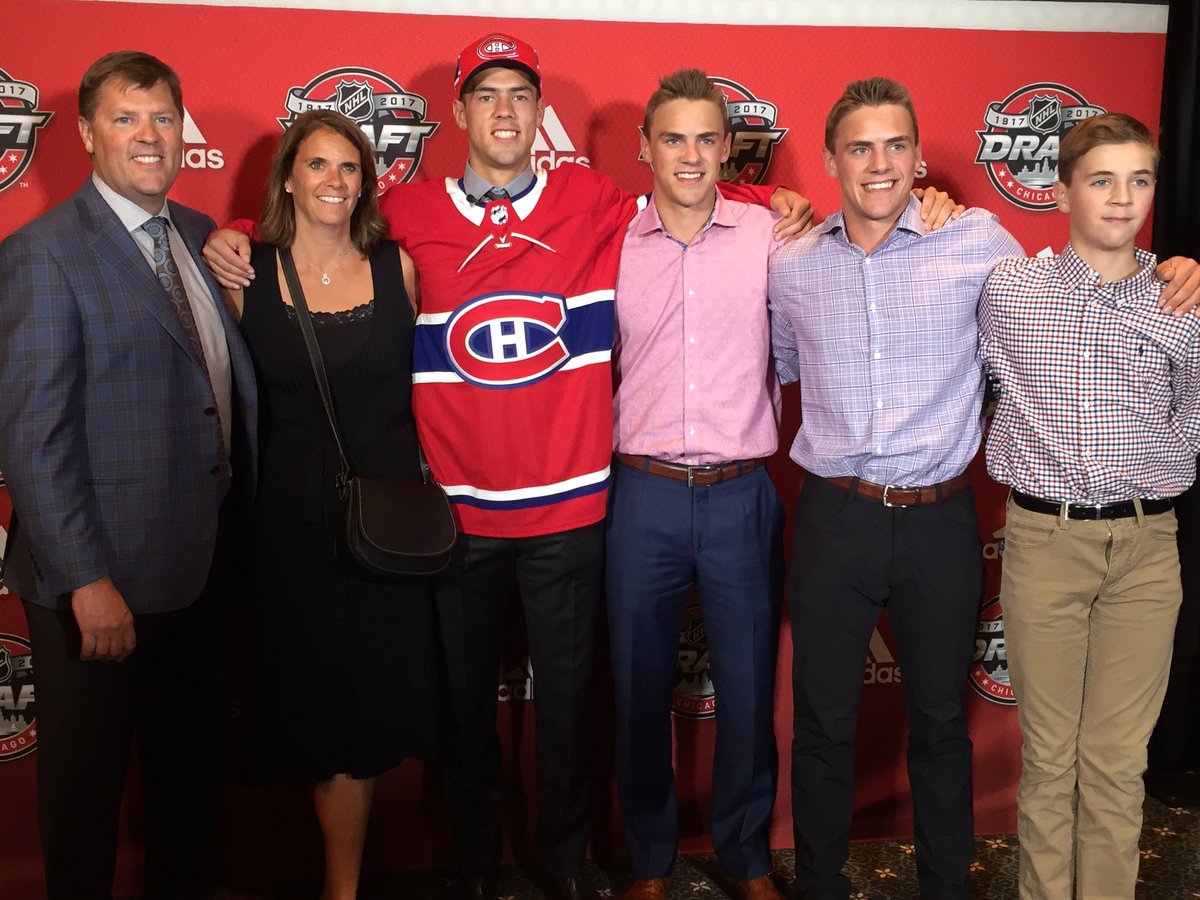
Ryan Poehling is the peach prospect, and there are a lot of scouts today who admit that he looks like he should have been taken in the top 15. Poehling has broken out as a sophomore in the NCHC, surpassing his rookie totals in short order as he became a dominant collegiate player almost overnight. His blossoming earned him a pivotal role on the US WJC this year, and that experience will only help him next season as he most assuredly will be given a vital offensive role with the team.
Josh Brook was the other Habs plum prospect who got injured early in the season…his first game in the rookie tournament in fact, and he only returned to WHL action last month for the high-flying Moose Jaw Warriors. Since his return though, Brook has demonstrated to everyone why he was so coveted by the Habs and ranked in the first round by Recrutes.
Brook through his first 15 games is averaging an assist-per-game, and even more impressive is already top 15 in plus/minus with a +24 rating. Projected over an entire season Brook is on pace to break +100, a figure almost unheard of in today’s junior hockey, and an indication of just how effective he is both offensively and defensively. A mobile, smart puck mover with high IQ and some jam, Brook play 30 plus minutes per game in all situation on the best team in the WHL. Brook looks like a future top-four NHL defenceman; there are no holes in his game, and it wouldn’t even shock me to see him on the top defence pairing some day.
Joni Ikonen played a top-two center role for Finland at the WJC before suffering an injury that hampered his play the rest of the way. To be afforded such a role on a strong WJC team at the age of 18 shows just how highly regarded he is by Finnish hockey, and just like Poehling he will be the favourite to be his team’s top center at the 2019 WJC.
Ikonen’s skating was just average at the WJC, and that will need to improve as he gets stronger. The competitiveness, skills, shot and smarts are there, so a solid offseason training will hopefully help him gain that extra step he will need to be a dominant junior next season.
Scott Walford dropped at the draft because he suffered an injury late last season and wasn’t seen a lot by the scouting community. This season, however, it has become apparent why the Habs drafted him, and he’s developed into one of the most dependable two-way defencemen in the WHL. Mobile, smart, skilled and competitive, Walford is already Victoria’s go-to defenceman on the PP and PK, and by next season will likely be one of the dominant defencemen in junior hockey, and may well be invited to Hockey Canada’s WJC summer camp. One could rightly argue that Walford should have been selected in the second round, and he looks like a third-pairing NHLer at worst some day.
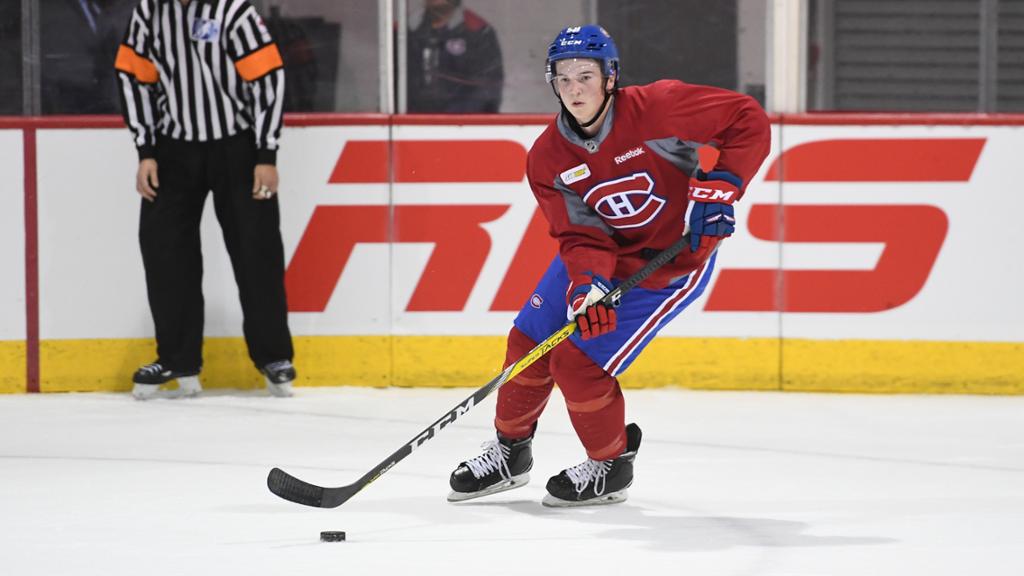
Cale Fleury dropped on draft day because his dreadful plus/minus rating of -61 made scouts question his hockey sense. As we’ve discovered this season though, that plus/minus was as much a product of being on an awful junior hockey team as any other reason, and he also had a lack of views because scouts weren’t going to see games involving a team in Kootenay that was consistently getting blown out..they are never good games to scout. Fleury was dealt last month to the Regina Pats, and there’s not horrible plus/minus stat this year as he’s had a solid campaign in his final junior season. A solid skater with good size and a heavy shot, Fleury has been solid since his move to the Pats, collecting 18 points in 22 games and posting a plus/minus of +9. Habs’ fans will get to see him in the Memorial Cup, and likely get an idea of why he was also a solid pick at 87th overall.
Jarret Tyszka had a horrible Memorial Cup last spring, and that hurt him significantly on draft day as a prospect once thought to be a second-round candidate dropped to the fifth round. A lanky 6-3 blueliner with good mobility, he is still very raw as he needs to add lots of weight before he’s anywhere close to being ready to compete for an NHL position, but he’s making strides offensively and on pace to finish this season with 50 points as an 18-year-old.
There will be lots of work to do and Tyszka’s the least likely of the four defencemen selected by the Habs to play in the NHL, but if everything comes together he certainly has the size/speed combo to play at the NHL level. The mental part of the game and gaining plenty of strength are the two most important areas he will need to improve.
The Habs were without a seventh-round pick last June, but when the last round was underway and goalie Cayden Primeau had surprisingly not been selected, the Habs picked up another pick and took Keith’s son with the 199th pick in the draft.
That move is looking like a great one today. Primeau has stepped in to the NCAA and been one of the best goalies in the nation as a raw rookie, compiling top-five stats in both goals against average and save percentage at Northeastern while compiling an 8-3-3 record.
Primeau is a solid candidate to be the starting goalie on the US team next season if his strong play continues. His stats are much better than both Jake Oettinger’s and Joseph Woll’s, and they were the US goalies at this year’s WJC. In 2016 Primeau played for USA Hockey at both the Ivan Hlinka and the WJAC where he backstopped the US to a Gold Medal, so it’s not like they don’t know of his capabilities.
In summation, the 2017 draft looks like it will produce a minimum of two NHLers for the Habs in Poehling and Brook, and there may be as many as five or six. The Habs had serious needs at center and on defence, and in one draft did a stellar job at addressing both positions.
On the surface, it’s easy to criticize Montreal’s recent drafting because there are no McDavids making a major impact on the team, and it’s easy to dismiss Sergachev because he was traded. That’s not on the scouting staff though. They didn’t draft Sergachev with the thoughts that he would be traded, they took who they thought was the best player available, and he’s turned out to be pretty good.
The two times in the past six years the Habs were given the opportunity to pick high-end prospects they did just that, and all projections also show that they’ve more than matched the “two players per draft” quota that Ferraro suggested makes an NHL team’s draft a successful one.
I count 21 prospects from Montreal’s last six drafts who have shown enough to be considered strong candidates to play in the NHL:
Galchenyuk
Hudon
McCarron
de la Rose
Lehkonen
Andrighetto
Scherbak
Lernout
Juulsen
Vejdemo
Sergachev
Mete
Poehling
Brook
Evans
Addison
Bitten
Pezzetta
Ikonen
Walford
Fleury
That is not a bad list in my estimation, and most certainly not barren. Obviously, they won’t all become regulars on the Habs, but it’s hard to argue that there aren’t a dozen NHLers in that group, which adds up to Ferraro’s “two per draft”. No, it’s not rife with first-liners…but you get those prospects with a top 15 selection, which is what the Habs will have this season, along with at least three second-round picks.
When given the opportunity with extra picks in the top 90 in the past five drafts, Timmins has shown that he will deliver, and in the past two years, the current scouting staff has had two of the better drafts in the league.
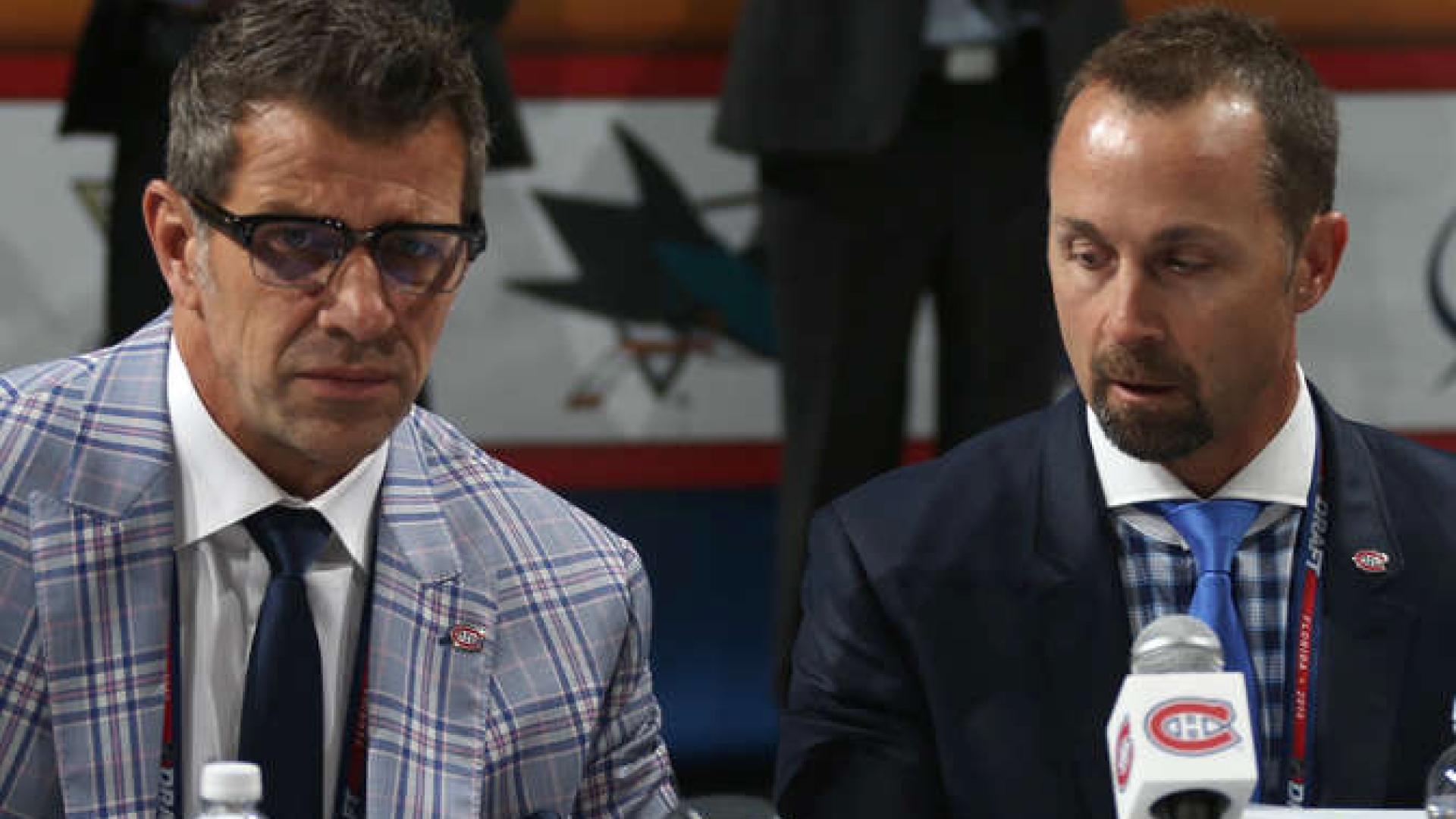
It’s important when you are assessing a scouting staff that you look at recent drafts as those are the ones that involved the current scouts. The Habs had some misses in the second round in 2012, but they also had a different staff at the time. This one has a good track record…and as far as I’m concerned the future looks bright in terms of Timmins and his crew restocking the prospect cupboard that was decimated by the dealing of multiple top 90 picks between 2008 and 2016.
Here is the bottom line. It is my contention that the Habs picked at least four players in 2013 who are or will be NHL regulars, two or three in 2014, two or three in 2015, 2-4 in 2016 and perhaps as many as five or six in 2017.
If my predictions come close to being true…even Ray Ferraro will look back in a few years…and yes…have to be impressed.
great read, very detailed, interesting article.